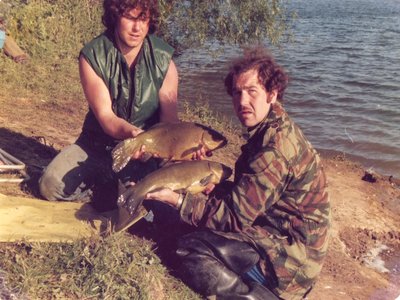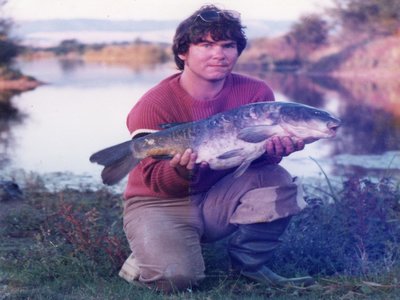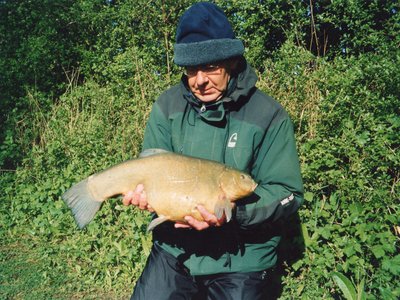It would not be pretentious to say that I was a Johnson’s pioneer; Martin Gay and I started seriously fishing for its tench in 1975 when the banks were relatively raw and the present-day forest unimaginable! To be honest, Johnson’s had been mentioned a few times in the angling papers but, mercifully, there had been no great rush to get down there. What Martin and I found were four pits, each with its own distinctive character. We chose the Island Lake that pleasant evening in July. We sat side-by-side with two rods apiece, each resting on matt black, Derek Romang ‘Heron’ conversions – and very good they were too. Bait was sweet-corn and the method was simplicity itself: two grains on a size 8, lightly link-legered into the darkness beyond the tall forest of pondweed just two rod-lengths out. Merely picturing the golden nuggets at rest, twelve feet down at the base of the margin shelf, brought about a near-palpable excitement that is hard to explain; like sending down a probe to unexplored depths in search of unseen monsters, the mystery and anticipation was all-consuming.
We sat without a piscine sniff right into the wee, small hours, and I remember asking Martin why he hadn’t re-cast one or both of his rods since we’d started some eight hours before. With what was to become – for me – classic MG pragmatism, he told me “No point…the bait won’t have come off so why bother?” Well…yes…but after so long, would you not be just a little concerned that… The thought snuck out and into the night as the logic of his words confounded me; the chances of his baits settling within a pair of empty bean-cans were pretty slim so yes…why bother? “A waste of valuable energy” he might reply.
It was freezing that night! I had fished a thousand nights before but never had I found myself as cold as I was then! Most uncharacteristically, I left the seated statue that was Martin Gay and sought a little warmth in my car, just behind. I fell asleep and awoke at sunrise to find the Medway Valley lightly dusted with frost! Martin, woolly hat a- twinkling, was still there, utterly unmoved and seemingly comatose. I looked at him in disbelief then woke him with my presence “Any good?” I didn’t deserve an answer but I got the bleedin’ obvious response all the same. His bobbins were unmoved and I asked if he’d stuck with the same casts he’d made at 5.30 the previous evening: he had. Then, as if by way of a genuine miracle, his nearest bottle-top peeeeped-up and smacked the glass – and Martin was in!
That first of Martin’s phenomenal tally of big Johnson’s tench went 5lb 9oz and neither of us had ever seen such a specimen of tinca vulgaris in our lives, raised as we were on rare, stunted Essex fish of barely two pounds: this was a proper tench.

A 6+ each for me and my brother from the Boat Lake, early 80s.
In the following seventeen years we both got married and moved house a couple of times; I changed jobs with some frequency and had two children; ‘New Romantic’ music came and went; Reagan sent troops to Grenada; the Berlin Wall fell; in-vitro fertilization succeeded; Mount St Helens erupted and Sharon Stone gave us a rare glimpse, but the love affair with Johnson’s and its big pristine tench never wavered. Understandably, fresh faces appeared with each new season and the consequent pressure compelled a change in our bait and method. Sweet-corn no longer did the trick close-in or at distance (not an easy task) and HNV baits became the order of the day. It may well have been that the HNV baits themselves were responsible for the failure of corn because, for sure, the formula used by Martin on the Boat Lake proved to be almost addictive and it is not impossible that the tench population of that lake took to shunning anything but. The proof was there. Close-range fishing for tench with any ‘standard’ bait was largely futile because, I firmly believe, Martin had schooled a great many of those fish to patrol a particular distant shelf in search of his bait. Runs were regular and decisive, no twitching or hesitation, just a smooth one-way bottle-top ascent to the rod and the rise of a tight line before striking. Tench were caught by others of course, but with nothing like the frequency that Mr. Gay reeled them in.

A tad under 17lbs, this was the Boat Lake ‘Mug Carp’, this time on floating crust. Today, the background to this shot would show a line of luxury, lake-side houses.
Those with the fanaticism to spend lengthy days and nights in pursuit of a species will know of those choppy, margin-slapping days that start full of promise but dwindle to nothing as the sun rises and lulls them into apathy… the welcome warmth that draws the chill of night but wakes them in their chairs, gasping for liquid and frantic to throw off their coats… On such days anglers become restless if not downright bored. They take to wandering along the bank for a chat, then back to base for another cup of tea and a few pages of a novel. So it goes on the long, long day…not a twitch, not a hope other than one mockingly delivered by a distant thunder-clapping carp. The calm and the cool of evening is a lifetime away and there’s little to do but read or, perhaps, scan the lake through their bins…
This was a typical scenario at Johnson’s throughout the summers of those seventeen years but way over there, near the corner, was a lone angler who appeared always to be busy and engaged with his rod. What, exactly, was he doing? Why was he always up and about? Who was he? It was Martin Gay, the man I write of so frequently because his expertise in the field of tench fishing has left such an impression. As the rest of us dossed about in the mid-day sun he was there, casting, catapulting, striking and unhooking four, five, six, seven tench in a day, all six and seven pounders and occasionally bigger. He’d take them from a wide shelf that linked a series of small islands and dropped-off into a twenty-five foot abyss. After casting the required eighty yards and firing-out no more than half a dozen baits he’d jot down the time then sit down to await events. As and when they arrived, he’d again take a note of the time, and in this way he was eventually able to predict fairly accurately when the shoal might or might not be present. When all was quiet the fish would be at, or patrolling toward, the far end of the shelf and this would take ‘x’ long enabling Martin to break-out his lunch and have a cup of tea in comfort. When they returned it was action stations with more powerful strikes and more fish on the bank – quite extraordinary. No bolt or hair rigs were used. The hook was always within the boilie, a piece of grass helping prevent a pull-through.

Martin caught big tench in Essex too. This is a 10lb + fish.
The lake Graham Elliott fished simply wasn’t there back then! It was just before the turn of the century, I think, when something happened to further raise the water level in the Johnson’s and Larkfield complex by something like 8-10 feet, creating what is now known as The Ocean and what is called the Road Lake. I have fished neither of these new water-worlds but would dearly love to return in the near future as a Mid-Kent member; syndication has solved the appalling litter problem and conserved the lakes’ wild and woolly nature. Is there anyone out there able – and willing! – to give an update on matters-Johnson? Who is the new Martin Gay? Is there one? Did the Boat Lake ever produce another big chub? Is it producing thirteen and fourteen pound leviathans nowadays? I dare you to tell me…










